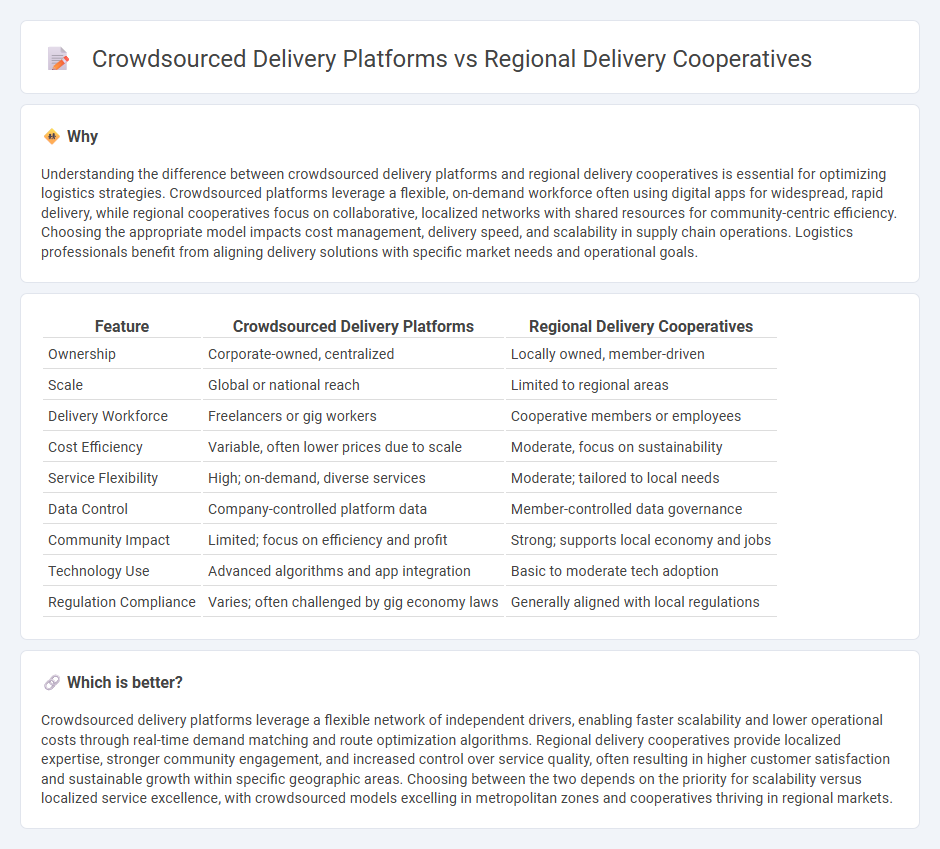
Crowdsourced delivery platforms leverage gig economy workers to provide flexible, on-demand logistics services, enhancing scalability and reducing operational costs for businesses. Regional delivery cooperatives focus on localized, community-driven networks that prioritize sustainability, fair compensation, and reliable service through shared resources and collective management. Explore how these innovative models are transforming logistics efficiency and customer satisfaction worldwide.
Why it is important
Understanding the difference between crowdsourced delivery platforms and regional delivery cooperatives is essential for optimizing logistics strategies. Crowdsourced platforms leverage a flexible, on-demand workforce often using digital apps for widespread, rapid delivery, while regional cooperatives focus on collaborative, localized networks with shared resources for community-centric efficiency. Choosing the appropriate model impacts cost management, delivery speed, and scalability in supply chain operations. Logistics professionals benefit from aligning delivery solutions with specific market needs and operational goals.
Comparison Table
| Feature | Crowdsourced Delivery Platforms | Regional Delivery Cooperatives |
|---|---|---|
| Ownership | Corporate-owned, centralized | Locally owned, member-driven |
| Scale | Global or national reach | Limited to regional areas |
| Delivery Workforce | Freelancers or gig workers | Cooperative members or employees |
| Cost Efficiency | Variable, often lower prices due to scale | Moderate, focus on sustainability |
| Service Flexibility | High; on-demand, diverse services | Moderate; tailored to local needs |
| Data Control | Company-controlled platform data | Member-controlled data governance |
| Community Impact | Limited; focus on efficiency and profit | Strong; supports local economy and jobs |
| Technology Use | Advanced algorithms and app integration | Basic to moderate tech adoption |
| Regulation Compliance | Varies; often challenged by gig economy laws | Generally aligned with local regulations |
Which is better?
Crowdsourced delivery platforms leverage a flexible network of independent drivers, enabling faster scalability and lower operational costs through real-time demand matching and route optimization algorithms. Regional delivery cooperatives provide localized expertise, stronger community engagement, and increased control over service quality, often resulting in higher customer satisfaction and sustainable growth within specific geographic areas. Choosing between the two depends on the priority for scalability versus localized service excellence, with crowdsourced models excelling in metropolitan zones and cooperatives thriving in regional markets.
Connection
Crowdsourced delivery platforms leverage local drivers to facilitate flexible, on-demand logistics, enhancing last-mile delivery efficiency. Regional delivery cooperatives aggregate resources and coordinate multiple local stakeholders to streamline distribution networks and reduce operational costs. The synergy between crowdsourced platforms and regional cooperatives optimizes delivery routes, increases service coverage, and boosts overall supply chain responsiveness.
Key Terms
**Regional Delivery Cooperatives:**
Regional delivery cooperatives prioritize local ownership and community-driven logistics, enabling greater control over delivery operations while supporting local economies. These cooperatives optimize delivery routes within specific regions, reducing transit times and environmental impact by leveraging localized knowledge and infrastructure. Explore how regional delivery cooperatives enhance efficiency and sustainability compared to crowdsourced alternatives.
Member-ownership
Regional delivery cooperatives emphasize member-ownership, where local stakeholders share decision-making power and profits, fostering community investment and accountability. Crowdsourced delivery platforms typically rely on independent contractors without ownership stakes, prioritizing scalability and flexibility over collective control. Explore how member-ownership models impact service quality and local economies by learning more about regional delivery cooperatives.
Profit-sharing
Regional delivery cooperatives prioritize equitable profit-sharing by distributing earnings among member drivers, fostering community ownership and sustainable income. Crowdsourced delivery platforms centralize profits with corporate stakeholders, often leaving drivers with variable pay and limited financial benefits. Discover more about how profit-sharing impacts delivery service models and driver livelihoods.
Source and External Links
Delivery Co-ops Provide an Answer to High Fees and Low Wages - Regional delivery cooperatives are worker- and business-owned entities that provide food delivery services in local communities as an alternative to large app-based platforms, pooling resources and profits among member restaurants and drivers in places like Ohio, Nebraska, and Washington, D.C.
Local Food Purchase Assistance Cooperative Agreement Program - This USDA program supports regional food cooperatives by funding local and regional food procurement and distribution, enhancing supply chain resiliency and economic opportunities for local producers within certain geographic areas.
Local Food and Cooperatives | NC State Extension - Cooperatives in the regional food system can legally organize producers, aggregators, distributors, and buyers to collectively manage local food distribution and delivery, often favoring cooperative models for their democratic, community-oriented structure.
 dowidth.com
dowidth.com